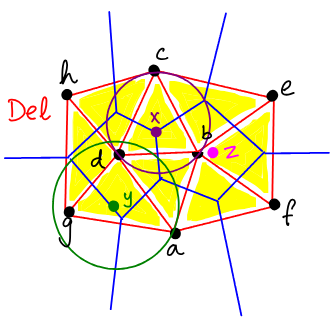Let be a -simplex with vertices in . We say is a weak witness for with respect to if
A weak witness is a strong witness if
For example, in the Delaunay complex below

is a strong witness for since each vertex is equidistant to . The point is a weak witness for and . As drawn,
One may notice that every triangle in has a strong witness at the center of the triangles circumcircle.
de Silva, 2003
A simplex has a strong witness if and only if every face has a weak witness.
The witness complex is all simplices that have a weak witness.
Witness Complex
The (strict) witness complex is the collection of simplices that have a weak witness in .
Relationship to Delaunay
One may see that a simplex if and only if has a strong witness. But if , then all faces have a weak witness implying by Theorem 1 that has a strong witness. As a result,
Computationally we often use the lazy witness complex, which similar to the Vietrois-Rips complex we find the 1-skeleton then fill in holes.
Lazy Witness Complex
The lazy witness complex is given by constructing the 1-skeleton of then adding if and only if each edge is in .
Choosing Landmarks
Before choosing landmarks, we need to determine . According to de Silva and Carlsoon (2004) if is sampled from surfaces in 3D then is a good upper bound.
Once you’ve determined the number of landmarks, there are two common methods.
- Random selection of points in
- Maxmin selection
Maxmin selection works by first picking the first landmark randomly. Then inductively, we choose the next landmark which maximizes the function
As a result, we get a widespread coverage of with the downside that we may end up with outliers as landmarks.